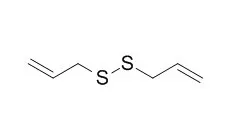| Description: |
Diallyl disulfide has antitumor effect, the effect can be enhanced by miR-200b and miR-22. Diallyl disulfide induces antioxidant defense mechanism by activating Nrf2 pathway and reduces inflammatory response by inhibiting NF-κB activation. Diallyl disulfide also has protective effect against CP-induced developmental toxicity. |
| Targets: |
IL Receptor | NOS | NF-kB | HO-1 | Nrf2 | Bcl-2/Bax | Caspase | IkB | P450 (e.g. CYP17) | TNF-α | TGF-β/Smad | IKK |
| In vitro: |
| Food Chem Toxicol. 2013 Dec;62:506-13. | | Diallyl-disulfide, an organosulfur compound of garlic, attenuates airway inflammation via activation of the Nrf-2/HO-1 pathway and NF-kappaB suppression.[Pubmed: 24051194] | Diallyl disulfide (DADS) is a major organosulfur compound found in garlic oil that is widely used as a flavoring agent.
METHODS AND RESULTS:
In this study, we evaluated the effects of DADS on airway inflammation using an ovalbumin-induced model of allergic asthma and RAW264.7 cells. DADS decreased nitric oxide production with a reduction in the levels of interleukins (IL)-1β and IL-6 in RAW264.7 cells stimulated with LPS. DADS also reduced the expression of proinflammatory proteins including inducible nitric oxide synthase (iNOS), nuclear factor (NF)-κB, and matrix metalloproteinase (MMP)-9, and it enhanced the expression of antioxidant proteins including Nrf-2 and hemeoxygenase (HO)-1. In in vivo experiments, DADS decreased the inflammatory cell count in the bronchoalveolar lavage fluid (BALF) with IL-4, IL-5, IL-13, and immunoglobulin (Ig) E. These results were consistent with the histological analysis. DADS attenuated the airway inflammation and mucus hypersecretion induced by OVA challenge. In addition, DADS induced the activation of Nrf-2 and the expression of HO-1. In contrast, DADS reduced the activation of NF-κB, iNOS and MMP-9.
CONCLUSIONS:
In conclusion, DADS reduced the airway inflammation via regulation of Nrf-2/HO-1 and NF-κB. These results suggest that DADS might represent a useful new oral therapy to treat allergic asthma. | | Food Chem Toxicol. 2014 Jul;69:312-9. | | Induction of cytochrome P450 3A1 expression by diallyl disulfide: protective effects against cyclophosphamide-induced embryo-fetal developmental toxicity.[Pubmed: 24769015] | The protective effects of Diallyl disulfide (DADS) on cyclophosphamide (CP)-induced developmental toxicity and the possible mechanisms involved in this protection were investigated in rats.
METHODS AND RESULTS:
In order to study the mechanisms involved in the protection, we examined the effects of DADS on the expression of cytochrome P450 (CYP) 3A1 in the maternal liver and placenta and oxidative stress in the maternal hepatic tissues caused by CP. CP caused severe embryo-fetal developmental toxicity and hepatic oxidative stress. In contrast, DADS treatment significantly attenuated CP-induced developmental toxicity and oxidative damage in the maternal liver. DADS also significantly increased expression of CYP3A1 in the maternal liver and placenta.
CONCLUSIONS:
These results indicate that the protective effects of DADS against CP-induced developmental toxicity may be due to its ability to promote detoxification of CP, primarily by inducing CYP3A1 expression in the maternal liver and placenta, and its potent antioxidant effects. |
|
| In vivo: |
| Food Chem Toxicol. 2014 Jan;63:174-85. | | The involvement of Nrf2 in the protective effects of diallyl disulfide on carbon tetrachloride-induced hepatic oxidative damage and inflammatory response in rats.[Pubmed: 24246655] |
METHODS AND RESULTS:
This study investigated the potential effect of Diallyl disulfide (DADS) against carbon tetrachloride (CCl4)-induced oxidative hepatic damage and inflammatory response in rat liver. Diallyl disulfide at doses of 50 and 100 mg/kg/day was administered orally once daily for 5 days, prior to CCl4 administration. Pretreatment with Diallyl disulfide attenuated CCl4-induced elevated serum transaminase activities and histopathological alterations in liver. It prevented the hepatocellular apoptotic changes with induction of Bcl-2-associated X (Bax), cytochrome c, and caspase-3 caused by CCl4. An increase in the nuclear translocation of nuclear factor-kappaB (NF-κB) and phosphorylation of I kappaB alpha (IκBα) was observed in the livers of CCl4-treated rats that coincided with induction of inflammatory mediators or cytokines. In contrast, Diallyl disulfide inhibited NF-κB translocation and IκBα phosphorylation, and that subsequently decreased inflammatory mediators. Furthermore, Diallyl disulfide prevented CCl4-induced depletion of cytosolic nuclear factor E2-related factor 2 (Nrf2) and suppression of nuclear translocation of Nrf2, which, in turn, up-regulated phase II/antioxidant enzyme activities. Taken together, these results demonstrate that Diallyl disulfide increases the expression of phase II/antioxidant enzymes and simultaneously decreases the expression of inflammatory mediators in CCl4-induced liver injury.
CONCLUSIONS:
These findings indicate that Diallyl disulfide induces antioxidant defense mechanism by activating Nrf2 pathway and reduces inflammatory response by inhibiting NF-κB activation. |
|






 Cell. 2018 Jan 11;172(1-2):249-261.e12. doi: 10.1016/j.cell.2017.12.019.IF=36.216(2019)
Cell. 2018 Jan 11;172(1-2):249-261.e12. doi: 10.1016/j.cell.2017.12.019.IF=36.216(2019) Cell Metab. 2020 Mar 3;31(3):534-548.e5. doi: 10.1016/j.cmet.2020.01.002.IF=22.415(2019)
Cell Metab. 2020 Mar 3;31(3):534-548.e5. doi: 10.1016/j.cmet.2020.01.002.IF=22.415(2019) Mol Cell. 2017 Nov 16;68(4):673-685.e6. doi: 10.1016/j.molcel.2017.10.022.IF=14.548(2019)
Mol Cell. 2017 Nov 16;68(4):673-685.e6. doi: 10.1016/j.molcel.2017.10.022.IF=14.548(2019)